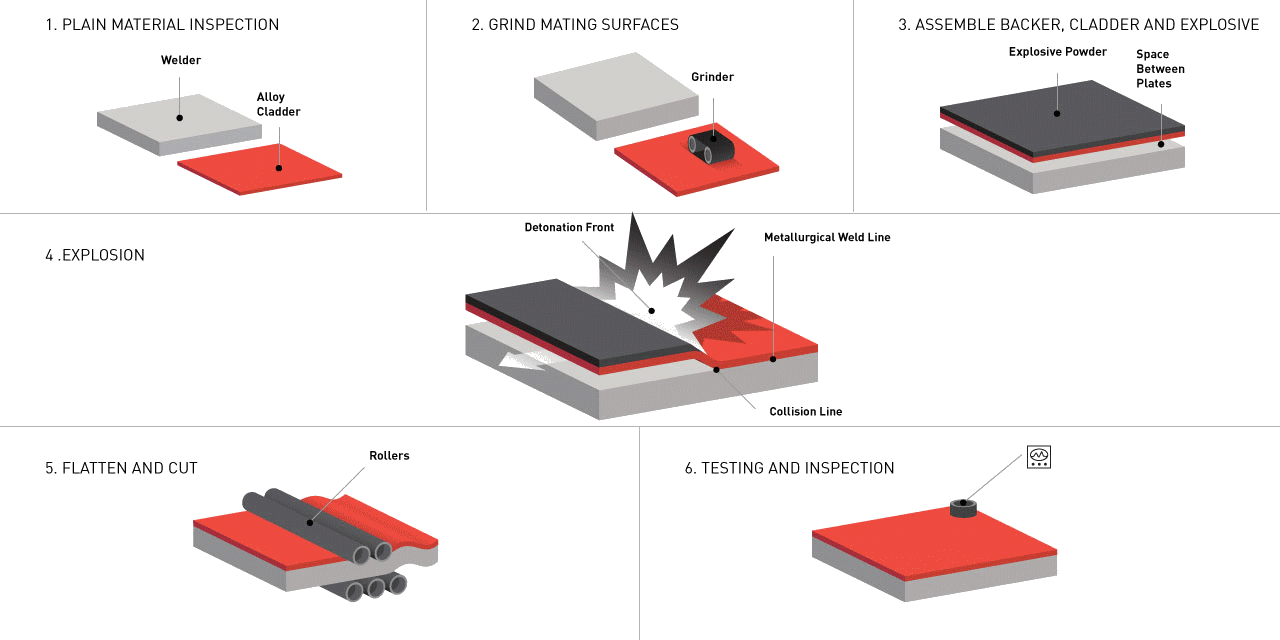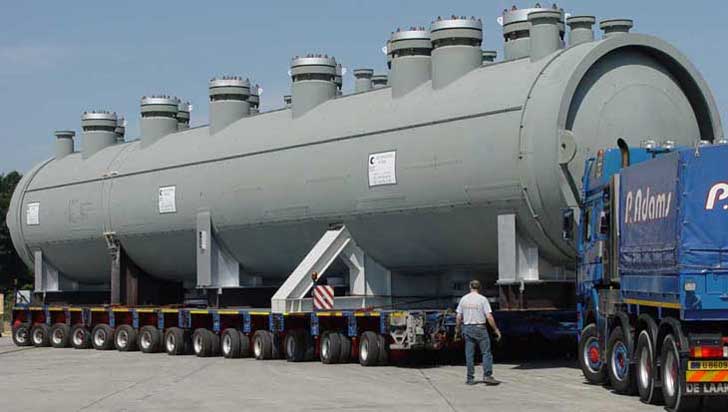Bonding Process
What is Explosion Cladding?
Explosion Bonding or Explosion Cladding or Explosion Welding is a technically based industrial welding process. As any other welding process, it complies with well understood, reliable principles. The process uses an explosive detonation as the energy source to produce a metallurgical bond between metal components. It can be used to join virtually any metals combination, both those that are metallurgically compatible and those that are known as non-weldable by conventional processes. Furthermore, this process can clad one or more layers onto one or both faces of a base metal, with the potential for each to be a different metal type or alloy.
The explosion cladding process was discovered in the late 1950's. By the end of the 1960's the process had been industrialized worldwide. During the near forty years of industrial application, the process has been continuously refined. Experienced manufacturers have codified the technology and the method of determining bonding parameters. In comparison to the 1960's, today manufacturers can produced much larger plates, up to 30 square meters, and have mastered the more difficult metals combinations including cladding zirconium onto stainless steel.
Terminology
- As with other welding processes, the explosion cladding process applies special terminology to many of the process variables.
- The Cladding Metal (also called the cladder) is the plate, which is in contact with the explosive. It is typically the thinner component.
- The Base Metal is the plate onto which the cladding metal is being bonded.
- The Standoff Distance is the separation distance between the cladding metal and the base metal when fixtured parallel to each other prior to the bonding operation.
- The Assembly Operation is the process in which the metals are fixtured into the proper positions for bonding, including setting standoff distance and explosive load.
- The Bonding Operation is the period in which the explosive detonation occurs and in which the actual bonding occurs.
 Image(s)..www.nov.com
Image(s)..www.nov.com
Principle
Preparation.. The first step of the cladding operation is the preparation of the two surfaces that are to be bonded together. These surfaces are ground or polished to achieve a uniform surface finish with a roughness Ra of 3 µm
(140 RMS) or below, dependent upon the metals combination and thicknesses.
Assembly.. The cladding plate is positioned parallel to and above the base plate, at a standoff distance which has been predetermined for the specific metals combination being bonded. This distance is selected to assure that the cladding plate collides with the base plate after accelerating to a specific collision velocity. The standoff distance typically varies from 0.5 to 4 times the cladder sheet thickness dependent upon the choice of impact parameters. The limited tolerance in collision velocity results in a similar tolerance control of the standoff distance.
The standoff distance is controlled by support spacers at the plate edges and internally as needed. Internal standoff devices are designed to be consumed by the jet.
An explosive containment frame is placed around the edges of the cladding metal plate. The height of the frame is set to contain a specific amount of explosive providing a specific energy release per unit area.
Bonding Operation.. The explosive composition and type is selected to yield a specific energy release and a specific detonation rate (the speed at which the detonation front travels across the explosive layer). The detonation rate must be subsonic to the acoustic velocities of the metals.
The explosive, which is generally granular, is uniformly distributed on the cladding plate surface filling the containment frame. It is ignited at a predetermined point on the plate surface using a high velocity explosive booster. The detonation travels away from the initiation point and across the plate surface at the specified detonation rate. The gas expansion of the explosive detonation accelerates the cladding plate across the standoff gap resulting in an angular collision at the specified collision velocity. The resultant impact creates very high-localized pressures at the collision point.
These pressures travel away from the collision point at the acoustic velocity of the metals. Since the collision is moving forward at a subsonic rate, pressures are created at the immediately approaching adjacent surfaces, which are sufficient to spall a thin layer of metal from each surface and eject it away in a jet. The surface contaminants, oxides and impurities are stripped away in the jet. At the collision point, the newly created clean metal surfaces impact at high pressures of several GPa. Although there is much heat generated in the explosive detonation, there is no time for heat transfer to the metals. The result is an ideal metal-metal bond without melting or diffusion.
Industrialisation
The explosion cladding process is commonly used for flat plates. The process can also be used for the manufacture of concentrically bonded tubes and pipes. In tube cladding, the explosive can be place inside the bore, or on the outside of the outer tube, dependent upon diameters, wall thicknesses and other factors. The process is not suitable for cladding of complex contoured surfaces. When shaped products are required, such as heads, the clad is produced as flat plate and formed into the required product configuration after bonding.
Cladding and Base metals
 The illustration above shows the wide range of combinations that can be done with explosion bonding.
The illustration above shows the wide range of combinations that can be done with explosion bonding.
Global dimensions of cladding sheets
The cladding global dimensions are typically limited only by the availability of flat component metal sheet or plate and transport constraints. Maximum plate size may also be limited by explosive detonation limits, such a noise and environmental constraints. Rarely is size limited by cladding know-how. The following maximum plate sizes can typically be produced..
- Length 12000 mm
- Width 5000 mm
- Base thickness 500 mm
- Cladding thickness 25 mm
- Surface 35 m²
Fabrication
Clad metal can be readily formed and welded as needed to construct process equipment. Many equipment fabricators worldwide have extensive expertise and know how in this area. Head and shell forming and welding of clad plates is well known by fabricators specializing in clad.
General Considerations
In many applications, particularly for large pressure vessels designed for high temperature and pressure, titanium or zirconium clad steel construction can be very economical compared to solid construction. Tantalum cost is so high that clad construction is the only economic alternative for most process equipment. Also, tantalum is not recognized by at least the ASME Code as a structural material, which would limit its application even if the economics of solid construction were favorable.
Clad should be more economical than solid construction where wall thickness is in excess of 19 mm to 32 mm in titanium, and 16 mm to 19 mm in zirconium.
With titanium or zirconium, a minimum lining thickness of 2.0 mm is usually specified based on concern for iron contamination from the backer material due to welding heat or burn through if the welder is careless. Use of a thinner liner is certainly feasible with careful welding process selection and welding parameters chosen to minimize penetration, but the cost saving is so minimal that this practice has largely been discontinued.
Tantalum is typically used in thickness of 1.0 mm. Due to high cost and higher melting temperatures, tantalum clad often utilizes a copper interlayer which carries away heat and minimizes the risk of weld contamination even with very thin liners.
Clad construction becomes relatively more expensive if there are more details like nozzles and penetrations that require significant detailed fabrication work. Cladding can be very low cost for large uninterrupted surfaces.
Solid construction may be superior where there is a requirement for a smooth interior surface since the normal detail of clad batten strip construction results in an uneven surface.
Advantages of Clad Construction
- The main reason for clad construction is economy.
- Cladding also allows application of titanium or zirconium at temperatures in excess of their design allowable in code construction.
Disadvantages of Clad Construction
- There is an inherent structural weakness in the fillet welds used to make joints in the liner itself. The biggest drawback is that a failure of one of these welds releases corrosive compounds throughout the backing material. This can lead to undetected corrosion. Further, fluid contaminants behind a lining make high quality repairs very difficult if not impossible. Loose linings are not generally suitable under vacuum.
- Clad construction is inherently complex compared to solid construction, particularly in structures with many nozzles, attachments, or complex internals.
- At least in titanium, clad equipment may be heavier than solid construction, which can increase the cost of foundations and supports, and may be a consideration in certain weight critical applications on offshore platforms, for example.
- The exterior of a clad vessel may require painting and field touch up as well as continuing maintenance of the paint system.
Reference.. Titanium Fabrication Corporation
Large Titanium Clad pressure vessels
 Image..www.coek.be
Image..www.coek.be